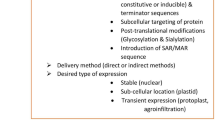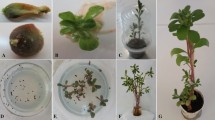Abstract
Plants provide a promising expression platform for producing recombinant proteins with several advantages in terms of high expression level, lower production cost, scalability, and safety and environment-friendly. Molecular pharming has been recognized as an emerging industry with strategic importance that could play an important role in economic development and healthcare in China. Here, this review represents the significant advances using transgenic rice endosperm as bioreactor to produce various therapeutic recombinant proteins in transgenic rice endosperm and large-scale production of OsrHSA, and discusses the challenges to develop molecular pharming as an emerging industry with strategic importance in China.






Similar content being viewed by others
References
An N, Ou J et al (2013) Expression of a functional recombinant human basic fibroblast growth factor from transgenic rice seeds. Int J Mol Sci 14(2):3556–3567
Andersen MR, Hyun Nam J et al (2011) Protein glycosylation: analysis, characterization, and engineering. Encyclopedia of industrial biotechnology: bioprocess, bioseparation, and cell technology. Wiley, New York, pp 1–59
Avesani L, Falorni A et al (2003) Improved in planta expression of the human islet autoantigen glutamic acid decarboxylase (GAD65). Transgenic Res 12(2):203–212
Bardor M, Faveeuw C et al (2003) Immunoreactivity in mammals of two typical plant glyco-epitopes, core α (1, 3)-fucose and core xylose. Glycobiology 13(6):427–434
Benchabane M, Goulet C et al (2008) Preventing unintended proteolysis in plant protein biofactories. Plant Biotechnol J 6(7):633–648
Bollen A, Herzog A et al (1983) Cloning and expression in Escherichia coli of full-length complementary DNA coding for human alpha 1-antitrypsin. DNA 2(4):255–264
Boothe J, Nykiforuk C et al (2010) Seed-based expression systems for plant molecular farming. Plant Biotechnol J 8(5):588–606
Chen LJ, Lee DS et al (2004) Gene flow from cultivated rice (Oryza sativa) to its weedy and wild relatives. Ann Bot 93(1):67–73
Daniell H, Singh ND et al (2009) Plant-made vaccine antigens and biopharmaceuticals. Trends Plant Sci 14(12):669–679
Fernandez-San Millan A, Farran I et al (2007) Expression of recombinant proteins lacking methionine as N-terminal amino acid in plastids: human serum albumin as a case study. J Biotechnol 127(4):593–604
Furtado A, Henry R et al (2008) Comparison of promoters in transgenic rice. Plant Biotechnol J 6:679–693
Gealy DR, Mitten DH et al (2003) Gene flow between red rice (Oryza sativa) and herbicide-resistant rice (O. sativa): implications for weed management 1. Weed Technol 17(3):627–645
Greenham T, Altosaar I (2013) Molecular strategies to engineer transgenic rice seed compartments for large-scale production of plant-made pharmaceuticals. Methods Mol Biol 956:311–326
He Y, Ning T et al (2011) Large-scale production of functional human serum albumin from transgenic rice seeds. Proc Natl Acad Sci USA 108(47):19078–19083
Horvath H, Huang J et al (2000) The production of recombinant proteins in transgenic barley grains. Proc Natl Acad Sci USA 97:1914–1919
Hwang Y, Yang D et al (2002) Analysis of the rice endospermspecific globulin promoter in transformed rice cells. Plant Cell Rep 20:842–847
Karnaukhova E, Ophir Y et al (2006) Recombinant human alpha-1 proteinase inhibitor: towards therapeutic use. Amino Acids 30(4):317–332
Kim Y, Lee J et al (2012) The suppression of the glutelin storage protein gene in transgenic rice seeds results in a higher yield of recombinant protein. Plant Biotechnol Rep 6:347–353
Krishnan H, Franceschi V et al (1986) Immunochemical studies on the role of the golgi complex in protein-body formation in rice seeds. Planta 169(4):471–480
Kusnadi AR, Nikolov ZL et al (1997) Production of recombinant proteins in transgenic plants: practical considerations. Biotechnol Bioeng 56(5):473–484
Li W, Xie T et al (2013) A short peptide in rice glutelin directs trafficking of protein into the protein storage vacuoles of the endosperm cells. Plant Mol Biol Rep 31:1492–1505
Luo J, Ning T et al (2009) Proteomic analysis of rice endosperm cells in response to expression of hGM-CSF. J Proteome Res 8(2):829–837
Ma JK-C, Hikmat BY et al (1998) Characterization of a recombinant plant monoclonal secretory antibody and preventive immunotherapy in humans. Nat Med 4(5):601–606
Ma JK, Drake PM et al (2003) The production of recombinant pharmaceutical proteins in plants. Nat Rev Genet 4(10):794–805
Messeguer J, Fogher C et al (2001) Field assessments of gene flow from transgenic to cultivated rice (Oryza sativa L.) using a herbicide resistance gene as tracer marker. Theor Appl Genet 103(8):1151–1159
Muntz K (1998) Deposition of storage proteins. Plant Mol Biol 38(1–2):77–99
Napier R, Fowke L et al (1992) Immunological evidence that plants use both HDEL and KDEL for targeting proteins to the endoplasmic reticulum. J Cell Sci 102(2):261–271
Ning T, Xie T et al (2008) Oral administration of recombinant human granulocyte-macrophage colony stimulating factor expressed in rice endosperm can increase leukocytes in mice. Biotechnol Lett 30(9):1679–1686
Obembe OO, Popoola JO et al (2011) Advances in plant molecular farming. Biotechnol Adv 29(2):210–222
Ogawa M, Kumamaru T et al (1987) Purification of protein body-I of rice seed and its polypeptide composition. Plant Cell Physiol 28(8):1517–1527
Oono Y, Wakasa Y et al (2010) Analysis of ER stress in developing rice endosperm accumulating b-amyloid peptide. Plant Biotechnol J 8:691–718
Paul M, Ma JK (2011) Plant-made pharmaceuticals: leading products and production platforms. Biotechnol Appl Biochem 58(1):58–67
Qu L, Takaiwa F (2004) Evaluation of tissue specificity and expression strength of rice seed component gene promoters in transgenic rice. Plant Biotechnol J 2:113–125
Rayon C, Lerouge P et al (1998) The protein N-glycosylation in plants. J Exp Bot 49(326):1463–1472
Rong J, Xia H et al (2004) Asymmetric gene flow between traditional and hybrid rice varieties (Oryza sativa) indicated by nuclear simple sequence repeats and implications for germplasm conservation. New Phytol 163(2):439–445
Rong J, Song Z et al (2005) Low frequency of transgene flow from Bt/CpTI rice to its nontransgenic counterparts planted at close spacing. New Phytol 168(3):559–566
Schähs M, Strasser R et al (2007) Production of a monoclonal antibody in plants with a humanized N-glycosylation pattern. Plant Biotechnol J 5(5):657–663
Sharma AK, Sharma MK (2009) Plants as bioreactors: recent developments and emerging opportunities. Biotechnol Adv 27(6):811–832
Shigemitsu T, Ozaki S et al (2012) Production of human growth hormone in transgenic rice seeds: co-introduction of RNA interference cassette for suppressing the gene expression of endogenous storage proteins. Plant Cell Rep 31:539–549
Song Z, Lu B et al (2012) A study of pollen viability and longevity in Oryza rufipogon, O. sativa, and their hybrids. Int Rice Res Notes 26(2):31–32
Song ZP, Lu BR et al (2003) Gene flow from cultivated rice to the wild species Oryza rufipogon under experimental field conditions. New Phytol 157(3):657–665
Stoger E, Sack M et al (2002) Practical considerations for pharmaceutical antibody production in different crop systems. Mol Breeding 9(3):149–158
Tackaberry ES, Prior FA et al (2008) Sustained expression of human cytomegalovirus glycoprotein B (UL55) in the seeds of homozygous rice plants. Mol Biotechnol 40(1):1–12
Tada Y, Utsumi S et al (2003) Foreign gene products can be enhanced by introduction into low storage protein mutants. Plant Biotechnol J 1(6):411–422
Takagi H, Hiroi T et al (2005) A rice-based edible vaccine expressing multiple T cell epitopes induces oral tolerance for inhibition of Th2-mediated IgE responses. Proc Natl Acad Sci USA 102:17525–17530
Takaiwa F, Takagi H et al (2007) Endosperm tissue is a good production platform for artificial recombinant proteins in transgenic rice. Plant Biotechnol J 5:84–92
Torres E, Vaquero C et al (1999) Rice cell culture as an alternative production system for functional diagnostic and therapeutic antibodies. Transgenic Res 8(6):441–449
van Ree R, Cabanes-Macheteau M et al (2000) β (1, 2)-xylose and α (1, 3)-fucose residues have a strong contribution in IgE binding to plant glycoallergens. J Biol Chem 275(15):11451–11458
Wu C, Adachi T et al (1998) Promoters of rice seed storage protein genes direct endosperm-specific gene expression in transgenic rice. Plant Cell Physiol 39:885–889
Wu J, Yu L et al (2007) Oral immunization with transgenic rice seeds expressing VP2 protein of infectious bursal disease virus induces protective immune responses in chickens. Plant Biotechnol J 5:570–578
Xie T, Qiu Q et al (2008) A biologically active rhIGF-1 fusion accumulated in transgenic rice seeds can reduce blood glucose in diabetic mice via oral delivery. Peptides 29(11):1862–1870
Yamagata H, Sugimoto T et al (1982) Biosynthesis of storage proteins in developing rice seeds. Plant Physiol 70(4):1094–1100
Yang D, Wu L et al (2001) Expression of the REB transcriptional activator in rice grains improves the yield of recombinant proteins whose genes are controlled by a Reb-responsive promoter. Proc Natl Acad Sci USA 98(20):11438–11443
Yang D, Guo F et al (2003) Expression and localization of human lysozyme in the endosperm of transgenic rice. Planta 216:597–603
Yang L, Tada Y et al (2006) A transgenic rice seed accumulating an anti-hypertensive peptide reduces the blood pressure of spontaneously hypertensive rats. FEBS Lett 580:3315–3320
Yang L, Suzuki K et al (2007) Development of transgenic rice seed accumulating a major Japanese cedar pollen allergen (Cry j 1) structurally disrupted for oral immunotherapy. Plant Biotechnol J 5:815–826
Yang L, Wakasa Y et al (2008) Biopharming to increase bioactive peptides in rice seed. J AOAC Int 91(4):957–964
Yang L, Hirose S et al (2012) Recombinant protein yield in rice seed is enhanced by specific suppression of endogenous seed proteins at the same deposit site. Plant Biotechnol J 10:1035–1045
Yasuda H, Hirose S et al (2009) Overexpression of BiP has inhibitory effects on the accumulation of seed storage proteins in endosperm cells of rice. Plant Cell Physiol 50(8):1532–1543
Zeitlin L, Olmsted SS et al (1998) A humanized monoclonal antibody produced in transgenic plants for immunoprotection of the vagina against genital herpes. Nat Biotechnol 16(13):1361–1364
Zhang L, Shi J et al (2012) Expression and characterization of recombinant human alpha-antitrypsin in transgenic rice seed. J Biotechnol 164(2):300–308
Zhang L, Jiang D et al (2013) The endoplasmic reticulum stress induced by highly expressed OsrAAT reduces seed size via pre-mature programmed cell death. Plant Mol Biol 83:153–161
Zimran A, Brill-Almon E et al (2011) Pivotal trial with plant cell–expressed recombinant glucocerebrosidase, taliglucerase alfa, a novel enzyme replacement therapy for Gaucher disease. Blood 118(22):5767–5773
Author information
Authors and Affiliations
Corresponding author
Additional information
Communicated by N. Stewart.
Electronic supplementary material
Below is the link to the electronic supplementary material.
Rights and permissions
About this article
Cite this article
Ou, J., Guo, Z., Shi, J. et al. Transgenic rice endosperm as a bioreactor for molecular pharming. Plant Cell Rep 33, 585–594 (2014). https://doi.org/10.1007/s00299-013-1559-2
Received:
Revised:
Accepted:
Published:
Issue Date:
DOI: https://doi.org/10.1007/s00299-013-1559-2




